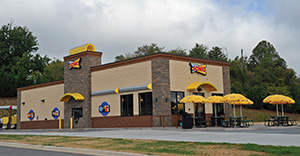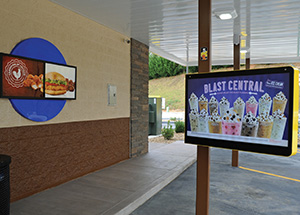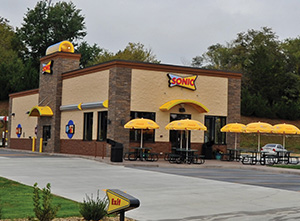SONIC finds masonry block and veneers to be the perfect recipe for new buildouts.
By Gary Hensley
In 1 year, SONIC food chains sell enough tater tots to circle the globe and give away more than enough mints to reach the top of the Empire State Building and back to the ground 5,000 times. And, their TV commercials featuring two comedic best friends at the drive-thru are classic.
For more than 60 years, SONIC has worked to build a dominant position in the drive-in restaurant business with award-winning meals served 1950s style on roller skates at approximately 3,500 locations in 45 states. Today, Sonic operates the largest chain of its kind in America from drive-in models that embrace innovation and are designed to meet specific geographic footprints and ranging consumer needs.
 However, while millions of customers are quite familiar with the company’s made-to-order signature menu items and speedy service from friendly carhops, they may not realize the behind-the-scenes technology and attention to detail the company employs to bring its famous tots, burgers and shakes to market. This unique focus starts the moment the company chooses to build a new location, which is fast-tracked for completion in only 5 weeks. Masonry was the overwhelming choice for the construction of a new SONIC “dine-in” concept in Weaverville, North Carolina.
However, while millions of customers are quite familiar with the company’s made-to-order signature menu items and speedy service from friendly carhops, they may not realize the behind-the-scenes technology and attention to detail the company employs to bring its famous tots, burgers and shakes to market. This unique focus starts the moment the company chooses to build a new location, which is fast-tracked for completion in only 5 weeks. Masonry was the overwhelming choice for the construction of a new SONIC “dine-in” concept in Weaverville, North Carolina.
When SONIC opens a new restaurant, it fast-tracks it to be completed and open for business 5 weeks from the time the shovel goes into the ground. It’s built into SONIC’s process and part of what is appealing to a franchisee — the fact that he or she is able to begin operating and making money in just over a month. However, it’s a very tight deadline for the contractor, and he or she needs every advantage to bring the project in on time while also meeting SONIC’s stringent quality expectations.
For the Weaverville project, co-contractors QED Solutions/Trace Hawke Construction sought to build the restaurant out of masonry block. “Our company has partnered with SONIC to build a number of their restaurants in the past, and we traditionally used wood framing,” says Trace Hawke, owner of Trace Hawke Construction. “After taking notice of the big box companies building with masonry block, I wondered if that might be a solution for SONIC in order to meet their desire to build a stronger, yet economical building. I met with my architect and together we designed a block building that would work anywhere in the country and eliminate any structure issues.”
 In addition to being a good structure solution, Hawke was pleasantly surprised at the additional efficiency that masonry block brings to a fast-tracked program. With so many stub ups in various places in the floor — mechanical, cabling, conduit, plumbing, etc. — building with a steel or wood stud wall leaves little to no room for error in placement. With block’s modular design, the contractor can place a footer, then lay the first course of block, then start pulling measurements. The floor doesn’t have to be poured like it does with a stud wall to start the building, so the mechanical contractor, plumber and electrician can all begin working at the same time and allow installation of the underground conduit while the walls are going up on the building. Once completed, the floor can be poured.
In addition to being a good structure solution, Hawke was pleasantly surprised at the additional efficiency that masonry block brings to a fast-tracked program. With so many stub ups in various places in the floor — mechanical, cabling, conduit, plumbing, etc. — building with a steel or wood stud wall leaves little to no room for error in placement. With block’s modular design, the contractor can place a footer, then lay the first course of block, then start pulling measurements. The floor doesn’t have to be poured like it does with a stud wall to start the building, so the mechanical contractor, plumber and electrician can all begin working at the same time and allow installation of the underground conduit while the walls are going up on the building. Once completed, the floor can be poured.
“With the split face block, I can do my veneer and structure all in one step and also perform all of my subcontracting work,” explains Hawke. “In addition to the speed at which we can build, the block building offers additional benefits to the restaurant such as fire resistance and moisture prevention. SONIC employees power-wash the floors each night and the seal on the block provides an excellent barrier against that water.”
In addition to the split face block, he also used a mix of thin stone veneers that are readily available in a variety of shapes and colors. They’re integrally colored and pre-finished with a rough-hewn texture on one or more faces of the unit. There are veneers that nicely emulate stacked stone and are designed to fit tight dimensional tolerances to reduce installation times. They also integrate color throughout and are ideal for non-load bearing applications that do require footings.
Rather than a smooth CMU, SONIC selected a masonry block with a unique, course texture that gives the building additional aesthetic character. Ultimately, this SONIC franchise will operate out of a sustainable and very low-maintenance building that is also an extremely attractive showcase of the company’s brand, which is very important in the competitive restaurant industry.
 Having had no issues at all on the job, Hawke notes that the combination of masonry block and varied stone veneers are the perfect recipe for fast food structures like SONIC and he plans to use this system on additional SONIC restaurants he is constructing throughout the country.
Having had no issues at all on the job, Hawke notes that the combination of masonry block and varied stone veneers are the perfect recipe for fast food structures like SONIC and he plans to use this system on additional SONIC restaurants he is constructing throughout the country.
— Gary Hensley is vice president, masonry sales, at Adams, an Oldcastle Company. Oldcastle Architectural’s new consolidated brand for masonry products and services, Echelon, represents the most comprehensive masonry offering in the industry. Echelon provides a singular go-to source and reliable partner who successfully completes projects from beginning to end.
